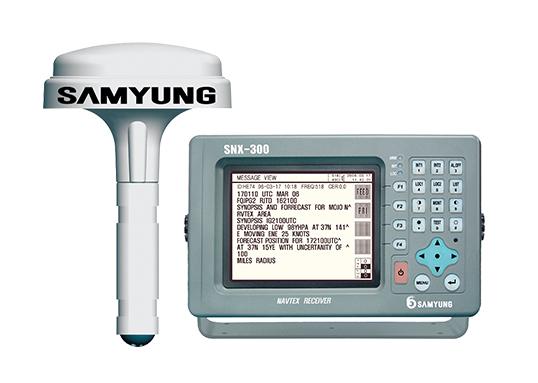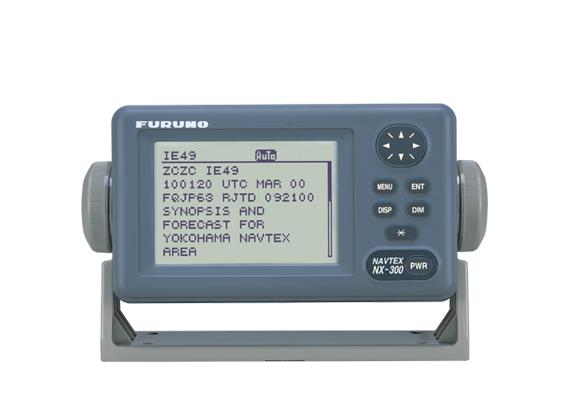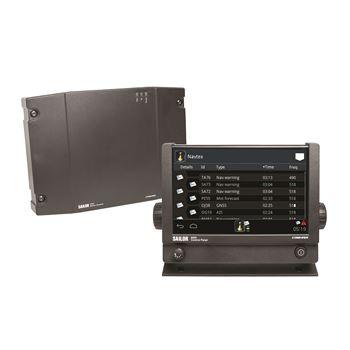The NAVTEX receiver is a Narrow Band Direct Printing (NBDP) device operating on the frequency 518 kHz
(some equipment can also operate on 490 and 4209.5 kHz), and is a vital part of the Global Maritime Distress
and Safety System (GMDSS).
It automatically receives Maritime Safety Information such as Radio Navigational Warnings, Storm/Gale Warnings, Meteorological Forecasts, Piracy Warnings, Distress Alerts, etc. (full details of the system can be found in IMO Publication IMO-951E - The NAVTEX Manual).
The information received is printed on the receiver's own paper recorder roll. Each message begins with a start of message function (ZCZC) followed by a space then four B characters. The first, (B1), identifies the station being received, the second, (B2), identifies the subject i.e. Navigational Warning, Met Forecasts, etc., and the third and fourth, (B3 + B4), form the consecutive number of the message from that station. This is followed by the text of the message and ends with an end-of-message function (NNNN).
The NAVTEX system broadcasts COASTAL WARNINGS that cover the area from the Fairway Buoy out to about 250 nautical miles from the transmitter; the transmissions from some transmitters can be received out to 400 nautical miles and even further in unusual propagational conditions.
The practical advice on the other side of this card will help to ensure that you make the most efficient use of your NAVTEX receiver, guaranteeing the reception of Maritime Safety Information within the respective coverage areas of the NAVTEX stations being used
For a NAVTEX receiver to function effectively, it is essential that the operator should have a sound knowledge of how to programme and operate his particular receiver. This is not difficult provided the following practical steps are followed:
1. Make sure that there are sufficient rolls of NAVTEX paper on board.
2. Check that there is paper in the receiver.
3. Turn the NAVTEX receiver on at least four hours before sailing, or better still, leaves it turned on permanently. This avoids the chance of losing vital information that could affect the vessel during its voyage.
4. Make sure that the Equipment Operating Manual is available close to the equipment, paying particular attention to the fact that your equipment may be programmed differently from other makes and models.
5. Using the Equipment Operating Manual, make a handy guide for programming, status, and auto-testing procedures for your vessel's equipment, place it in a plastic cover, and keep it with the equipment.
6. Have available next to the equipment a plasticized copy of the NAVAREAs/METAREAs in which the vessel is likely to sail, showing the NAVTEX stations, their coverage ranges, their respective time schedules, and B1 characters.
7. Programme your receiver to accept only those messages identified with the B1 character of the NAVTEX station which covers the area in which your vessel is currently sailing and the one covering the area into which you are about to sail. This will avoid the equipment printing information which has no relevance to your voyage and will avoid unnecessary waste of paper.
8. Programme your receiver to accept only those messages identified with the B2 characters (type of message) you wish to receive. It is recommended that most B2 characters (A to Z) be programmed, but you may exclude those for navaid equipment (Decca or Loran for example) with which your vessel is NOT fitted. Be aware that the characters A, B, and D MUST be included, as they are mandatory.
9. Take extra care not to confuse the programming of B1 characters (station designators) with those of B2 characters (type of messages). It is very easy for an operator to believe that he/she is programming B1 characters when in fact they are programming B2 characters. After programming ALWAYS CHECK the program status to ensure that it is correct.
10. If information is received incomplete/garbled, inform the relevant NAVTEX station, giving the time of
reception (UTC) and your vessel's position. By so doing, not only will you obtain the information you require,
but you will also help to improve the system. In the same way, any safety-critical occurrences observed during
the voyage must be passed immediately to the nearest (or most convenient) Coast Radio Station and addressed
to the relevant NAVAREA/METAREA or National Co-ordinator responsible for the area in which you are
sailing.

SNX-300 SAMYUNG
Designed to IMO resolution and performance standards effective from July 1st . 2005 (IMO Resolution MSC.148(77) ITU-R, M.540-2, M.625-3, IEC-61162).
• English channel (518KHz) & local channel (490KHz/4209.5KHz) are simultaneously receiving by two receivers built-in.
• Receiving messages sets-up from outer navigational equipment and channels.
• Storage for over 200 advisory including 8,000 receiving letters in average length per channel.
• 50 messages permanently stored per channel and 72-hour-long storage of receiving letters.
• Automatic power blockage run by voltage protection circuit.
• Interfaced to INS (Integrated Navigation System) according to IEC-61162.

NX-300 FURUNO
Economical - Paperless navtex receiver
Receiving Frequency
518 and 490 kHz selectable
Mode of Reception
F1B
Display Mode
Message Selection mode, Nav Data mode
MESSAGE STORAGE
28,000 characters
The NX-300 receives NAVTEX messages and verifies the ID of received messages.
It features two narrowband receivers, one tuned to the 518 kHz international Navtex frequency and the other to the 490 kHz domestic or local country frequency.

SAILOR 6391
Included in system
SAILOR 6390 Navtex Receiver
SAILOR 6004 Control Panel
- Power cable
- Mounting Bracket
- Mounting screws
- Flush Mount kit
- Installation Guide
- Test sheet
- ThraneLINK enabled